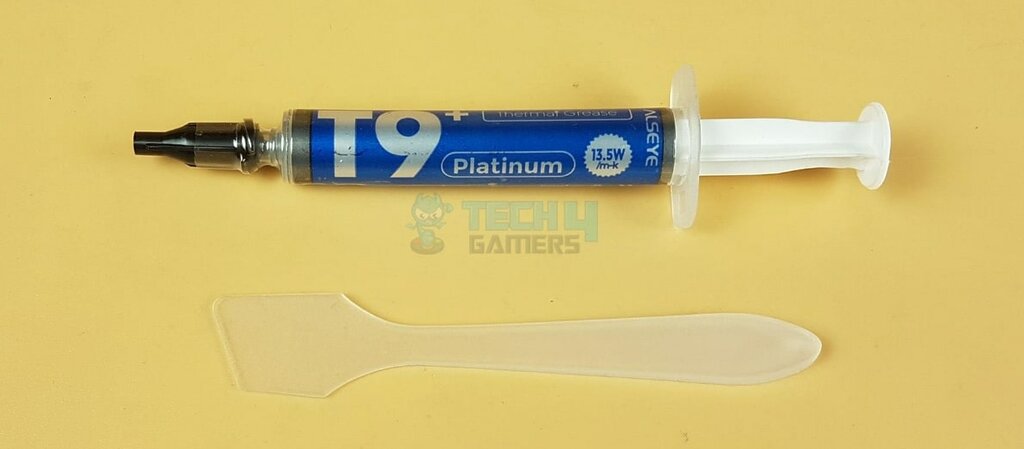If you are a gamer, content creator, or PC user, you should have heard Thermal Paste. While thermal paste itself is simple, it still plays a crucial role in cooling your CPU. A poor choice or use of thermal paste can cause heavy losses that include but are not limited to performance loss, component damage, or potential instability. In this guide, we will tell you all about thermal paste, from what it is to how to apply it. This way, you can avoid making basic mistakes and build your PC safely.
Key Takeaways
- Thermal Paste is the high thermal conductivity viscous substance applied between the CPU and heatsink surfaces to create an efficient thermal interface for heat conduction.
- Common application patterns for thermal paste are dot pattern, “X” pattern, spreading pattern, and line pattern.
- Clean the surfaces before applying thermal paste, then evenly spread it. Use a suitable application pattern; “pea-sized” or “rice-sized” dot patterns are the most popular.
- Common types of thermal paste are silicone-based, metal-based, ceramic-based, and carbon-based.
What Is Thermal Paste?

Thermal paste is a viscous substance with high thermal conductivity. It is applied between the CPU and the heatsink to fill the small gaps and imperfections between the surfaces[1]. These gaps can negatively impact heat transfer. By filling these gaps, thermal paste creates a more efficient thermal interface for heat transfer. Additionally, some other widely used names for thermal paste are thermal gel, thermal grease, and thermal compound.
Without thermal paste, the processor may overheat, which can cause damage to the component or even lead to system failure[2]. Therefore, it is essential to use high-quality thermal paste and to apply it correctly to ensure optimal performance and longevity of the electronic components.
How Does Thermal Paste Work?
Thermal paste improves the heat conduction between the CPU and the heatsink. As we know, CPUs generate significant heat during their operation that is dissipated by the heatsink into the surrounding environment[3]. However, the surface of the CPU and the heatsink is not perfectly flat. Tiny gaps or air bubbles between these surfaces can trap heat and reduce heat transfer efficiency[4].
Therefore, we use the thermal paste to fill these gaps, ensuring better contact between the CPU and the heatsink. This results in a more effective heat transfer from the CPU to the heatsink. Heatsink then dissipates this heat through its fins to the surrounding air by the system’s fans or other cooling solutions.
How To Apply Thermal Paste?
You must adequately apply the thermal paste to achieve optimal heat transfer. Here’s a three-step guide on how to apply thermal paste correctly:
- Clean the CPU and heatsink with isopropyl alcohol or thermal paste cleaner.
- Apply a small amount of thermal paste (pea-sized or rice-sized) to the CPU center.
- Spread the thermal paste evenly with a plastic card or spreading tool, avoiding excessive pressure.
Different Thermal Paste Patterns:
The “pea-sized” or “rice-sized” dot pattern is the most popular pattern for applying thermal pastes. However, you can also use other patterns for optimal coverage[5]. These include the “X” pattern, the “spreading” pattern, and the “line” pattern.
- X Pattern: The “X” pattern is suitable for larger surface area CPUs which involves applying the thermal paste in an “X” shape on the CPU. We recommend this method to ensure even coverage of the CPU surface.
- Spreading Pattern: For CPUs with integrated heat spreaders (IHS), the “spreading” pattern is most common, which involves applying a thin layer of thermal paste across the entire CPU surface using a plastic card or a thermal paste spreading tool.
- Line Pattern: Lastly, the “line” pattern involves applying a thin line of thermal paste horizontally or vertically across the center of the CPU. Usually, this method is used for CPUs with smaller surface areas or when using direct-die cooling methods.
How To Remove and Reapply Thermal Paste?

If you need to remove the thermal paste, here’s a three-step guide on how to do it:
- Use isopropyl alcohol or a specialized cleaner to remove the old thermal paste from the surface of the CPU and the heatsink. Ensure they are clean and dry.
- Apply a new layer of thermal paste according to the earlier instructions.
- Reattach the heatsink to the CPU and secure it per the manufacturer’s instructions.
Types of Thermal Paste
Different types of thermal paste are available in the market, each with unique properties and applications[6]. Some common types of thermal paste include:
- Silicone-based: They are the most common type of thermal paste, known for their affordability and ease of use. They have moderate thermal conductivity and are suitable for general CPU cooling purposes.
- Metal-based: They are made of silver or copper and are known for their high thermal conductivity and excellent heat transfer properties. They are ideal for high-performance systems that require maximum heat dissipation, such as gaming PCs or overclocked CPUs.
- Ceramic-based: Ceramic-based thermal pastes are known for their durability and stability at high temperatures. They have low thermal conductivity, which makes them suitable for lower-power CPUs or applications where the risk of electrical conductivity is a concern.
- Carbon-based: Carbon-based thermal pastes are known for their non-conductive properties, making them ideal for systems where the risk of short circuits is a concern. They have moderate thermal conductivity and are often used when electrical insulation is a priority.
Other Helpful Resources By Tech4Gamers:
References:
- How does heat sink compound (thermal paste) work. Retrieved from https://www.chemtronics.com/how-does-heat-sink-compound-thermal-paste-work
- Can Bad or Low-Quality Thermal Paste Cause Overheating? (Solution to Fix It!). Retrieved from https://koolingmonster.com/insights/can-bad-or-low-quality-thermal-paste-cause-overheating-solution-to-fix-it
- Thermal paste – a critical tool for thermal conductivity. Retrieved from https://www.arrow.com/en/research-and-events/articles/thermal-paste-a-critical-tool-for-heat-management
- Millicent Kwamboka (March 27, 2023). Maximizing Thermal Performance With Thermal Paste. Retrieved from https://eepower.com/technical-articles/maximizing-thermal-performance-with-thermal-paste/#
- The Ultimate Guide to Applying Thermal Paste. Retrieved from https://www.toolify.ai/hardware/the-ultimate-guide-to-applying-thermal-paste-2895994
- Christopher Trick (May 16, 2022). What is a Heat Sink, and How Does it Work. Retrieved from https://www.trentonsystems.com/en-us/resource-hub/blog/what-is-a-heat-sink
FAQs
Reapply the thermal paste every 1-2 years or whenever you remove the heatsink for any reason. The frequency may vary depending on the type of thermal paste used, system usage, and operating temperatures.
Reusing thermal paste may result in poor heat transfer and reduced cooling performance. So, you should avoid reusing the old thermal paste.
Different thermal pastes can have other properties. We do not recommend mixing them as it may result in unpredictable performance and potential damage to your CPU components.
Thank you! Please share your positive feedback. 🔋
How could we improve this post? Please Help us. 😔
[Wiki Editor]
Ali Rashid Khan is an avid gamer, hardware enthusiast, photographer, and devoted litterateur with a period of experience spanning more than 14 years. Sporting a specialization with regards to the latest tech in flagship phones, gaming laptops, and top-of-the-line PCs, Ali is known for consistently presenting the most detailed objective perspective on all types of gaming products, ranging from the Best Motherboards, CPU Coolers, RAM kits, GPUs, and PSUs amongst numerous other peripherals. When he’s not busy writing, you’ll find Ali meddling with mechanical keyboards, indulging in vehicular racing, or professionally competing worldwide with fellow mind-sport athletes in Scrabble at an international level. Currently speaking, Ali has completed his A-Level GCEs with plans to go into either Allopathic Medicine or Business Studies, or who knows, perhaps a full-time dedicated technological journalist.
Get In Touch: alirashid@tech4gamers.com


 Threads
Threads![What Are Fan Bearings? [Sleeve, Ball & Fluid] Fan Bearings](https://tech4gamers.com/wp-content/uploads/2023/08/HOW-TO-3-1-218x150.jpg)



